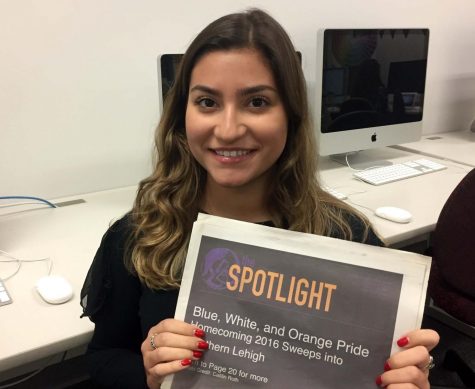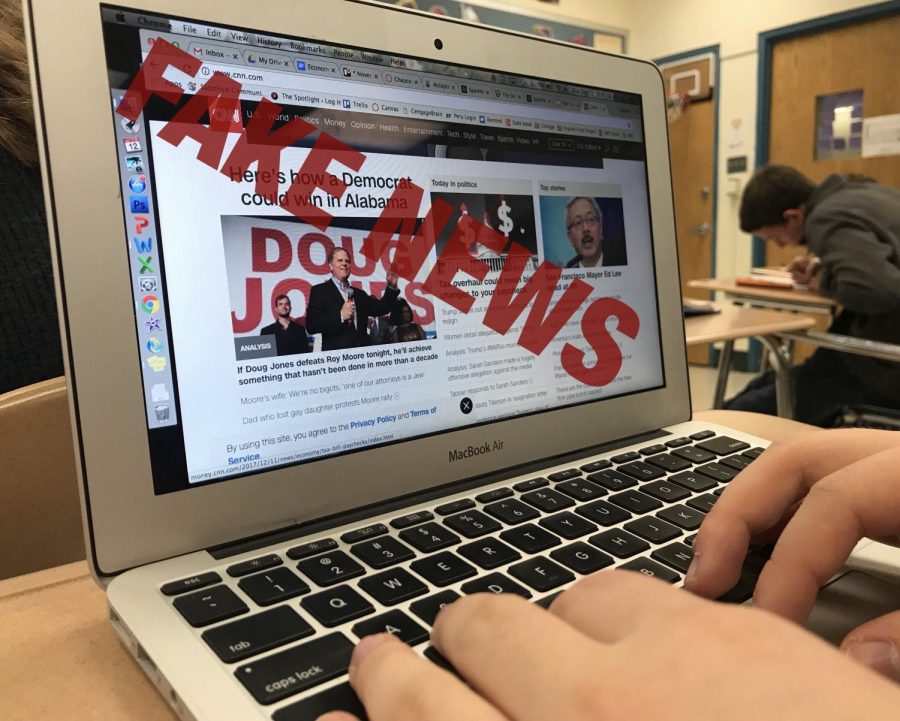How “Fake News” Affects American Politics
Labeling news media outlets as “fake news” has become increasingly commonplace in Trump’s America. Photo credit: Sarah Trebicka
While “fake news” has been around for decades, it is no secret that in President Donald Trump’s America, the term is being thrown around quite often by both prominent government officials and political activists alike. However, despite what may seem to be a self explanatory two-worded phrase, confusion may occur regarding what the speaker really means when they brand a story as “fake news,” and whether their claims may be politically motivated.
What Constitutes Fake News?
According to a 2017 study by Hunt Allcott and Matthew Gentzkow of Stanford University titled “Social Media and Fake News in the 2016 Election,” fake news refers to “news articles that are intentionally and verifiably false, and could mislead readers.” Fake news does not include unintentional reporting mistakes, rumors that were not fabricated by a particular news source, conspiracy theories, satire that is unlikely to be misconstrued as factual, false statements made by politicians themselves, and reports that are biased or misleading but not fabricated.
“When I think of the term ‘fake news,’ I literally think of people who are being paid to generate stories that are untrue for economic gain or political gain,” social studies teacher Mrs. Katie Quartuch, who wrote a dissertation in media literacy, said.
How Does Fake News Factor Into Today’s Political Climate?
The same Stanford University study found that fake news likely played a role in the election of President Trump. Fake news stories both widely shared and heavily tilted in favor of Donald Trump were shared on Facebook a total of 30 million times, and pro-Clinton fake stories were shared a total of 7.6 million times. This translates into 760 million instances of a user clicking through and reading a fake news story, or about three stories read per American adult.
According to Politifact, as of November 6, 2017, President Trump has used the phrase “fake news” at least 153 times in 2017. Despite the term’s intended meaning of fabricated content, critics argue that Trump’s own definition differs greatly. Because of when he uses the term, he has been accused of only labeling articles that paint a less-than-perfect picture of his presidency as “fake news.”
For example, on October 1, 2017, when Hurricane Maria ravaged Puerto Rico, Trump tweeted, “We have done a great job with the almost impossible situation in Puerto Rico. Outside of the Fake News or politically motivated ingrates,” seemingly implying that the media fails to credit him for positive actions. Trump cried “fake news” again at a campaign-style rally in Phoenix, Arizona, as the crowd roared with cheers and applause.
“[Journalists] are truly dishonest people. And not all of them … You’ve some very good reporters … But for the most part, these are really, really dishonest people. These are bad people,” President Trump said in Phoenix. “And I think they do not like our country … The only people giving a platform to hate groups [from the Charlottesville “Unite the Right” march] is the media itself and the fake news.”
According to Politifact, his “fake news” targets are mainly The New York Times, with 12 mentions, CNN with 23 mentions, NBC, with 19 mentions, and the Washington Post, with eight mentions.
“I think that President Trump was sensitive to a concern that many Americans had that the media was elitist and leftist,” Mrs. Quartuch said, “and that he’s using that emotion to further the trust divide between the people and journalists.”
“I believe that President Trump sees the media as his enemy. Because there are constantly negative news stories surrounding him, he dislikes [the news],” junior Christine Reichard said. “Since he is the president, his opinion towards the media has influence on citizens’ opinions as well.”
Trump’s constant criticism of the media has undoubtedly sown division within a nation built on healthy civil discourse. While liberals come to the defense of journalists, conservatives tend to be slightly more critical of news content, citing an innate liberal bias in most mainstream media.
“As a believer in democracy and a civics teacher, I think we’re in great danger if we don’t have journalists we can trust,” Mrs. Quartuch said. “I believe we need good journalists; it’s a fundamental piece to allowing us to be active in our democracy. And if we simply discount their work or their expertise, we’re damaging our ability to actually understand complicated things in the world.”
Political Polarization in Terms of News Sources
According to a Pew Research Center study, in 2014, the top five most trusted news outlets were The Economist, BBC, NPR, PBS, and The Wall Street Journal, and the most distrusted were BuzzFeed, The Rush Limbaugh Show, The Glenn Beck Program, The Ed Schultz Show, and Al Jazeera America. Major media players like The New York Times, The Washington Post, and MSNBC were “more distrusted than trusted” by conservatives, and more “trusted than distrusted” by liberals. Conversely, outlets like Breitbart and The Blaze were “more distrusted than trusted” by liberals and “more trusted than distrusted” by conservatives. Additionally, 14 percent of conservatives trusted CNN compared to 88 percent who did not. From a general standpoint, the right tended to be more skeptical of mainstream media than the left.
“I think mainstream media is a good way for the majority of the population to stay informed on what’s going on around them, but they’re also companies that can easily sell stories they wanna sell and therefore should be trusted with caution,” senior Jillian Werbisky said.
How Do Opposite Sides of the Political Spectrum Define Fake News?
A 2017 Politico poll found that 46 percent of voters believe the media fabricates news stories about Trump and his administration, 37 percent believe the media does not, and 17 percent are undecided. From a partisan standpoint, 76 percent of Republican voters believe media has invented fake news about Trump, along with 20 percent of Democrats and 44 percent of independents. Among the voters who strongly approve of President Trump’s performance as president, 85 percent believe the media fabricates stories about the president and his administration.
“I think [fake news has] manifested itself in a partisan way, but I don’t think it’s innately a partisan issue; people have used it to make partisan points,” Mrs. Quartuch said. “I think it has to do with people’s perception of the media being liberal.”
According to a 2017 Pew Research study based on an analysis of more than 3,000 stories across 24 media outlets, during the early days of Trump’s administration, 54 percent of news stories that mentioned one of his tweets provided a negative assessment of his words or actions, or a direct refutation of the tweet itself. Overall, 44 percent of all news stories studied during Trump’s first 100 days as president contained a negative assessment. Conservatives may cite this as an example of liberal bias in the media affecting journalists’ ability to fairly assess Trump, while liberals may describe such reporting as simply fact-checking the president. Therefore, an important question arises: is unfair or inaccurate reporting the same as fake news stories?
“It should be understood that the majority of media outlets are biased to some degree, but it doesn’t mean that their news is fake,” Werbisky said.
In 2003, Jayson Blair of the New York Times was exposed for committing acts of journalistic fraud such as widespread fabrication and plagiarism. Around the same time, foreign correspondent Jack Kelley of USA Today plagiarized and fabricated stories illustrating dangerous experiences in turbulent areas like Jerusalem. Stephen Glass, who was a staff writer for The Republic in the 1990s, is known as another “serial fabricator” of news stories. Therefore, fraudulent journalism does happen, but it happens rarely. Biased reporting is not considered fake reporting.
How Can Americans Access Reliable News Sources?
“I think good news sources have statistics and concrete evidence to back up their claims,” Werbisky said. “They have people of all different political ideologies, not just one ideology, covering stories, and they cover more than one type of news story.”
The Society of Professional Journalists (SPJ) provides a code of ethics on their website that includes core practices such as seek truth and report it, minimize harm, act independently, and be accountable and transparent.
According to FORBES magazine, some of the best news sources that successfully exercise these standards are The New York Times, The Wall Street Journal, The Washington Post, BBC, The Economist, The New Yorker, Reuters, Bloomberg News, The Associated Press, and Politico.
“In civics and government, we are doing lessons on how to trust online sources. We recommend checking the about section of a website, looking for biographies of writers or contributors, opening new tabs to cross check claims and stories, clicking on links that actually take them to the poll or study that’s being reported on so that they can read firsthand the account of it and then compare that to how it’s being reported upon,” Mrs. Quartuch said.
The Stanford University study also observed that both Democrats and Republicans are about 15 percent more likely to believe ideologically aligned headlines, which can lead to ideologically segregated social media networks. Therefore, making sure both sides of the political spectrum are accessing all sides of the story rather than one can also ensure reliability in news consumption.

Senior Sarah Trebicka is a four-year staff reporter and former two-year Our World editor, now serving as editor-in-chief for the Spotlight. In addition...


